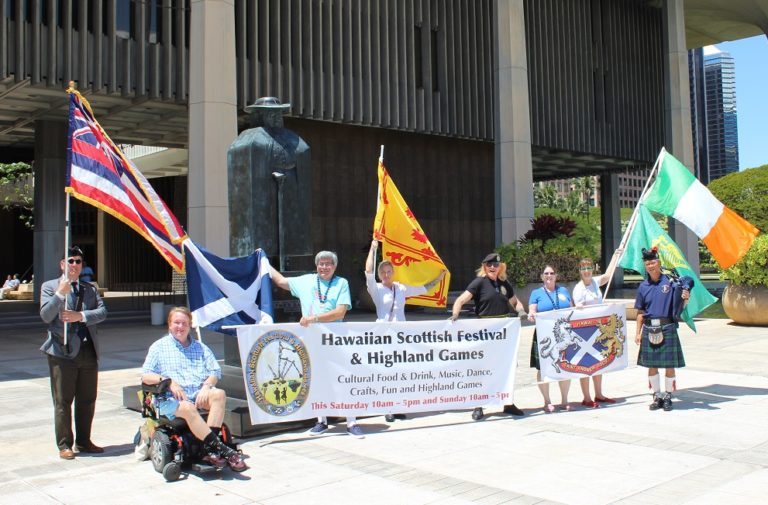Tartan Day is a North American celebration of Scottish heritage, observed April 6, the date on which the Declaration of Arbroath (Scottish Declaration of Independence) was submitted to Pope John XXII, in 1320. It was written in Latin, and essentially decreed Scots will choose their own king, and furthermore, Scotsmen rejected the propaganda that God desired the English kings to victimize and abuse them. Among the signatories of this papal protest was Walter Stewart, 6th High Steward of Scotland, the progenitor of my ancestors, the Stewart Kings of Scotland. Throughout the North American Continent, Tartan Day was celebrated this past weekend.
There are well over 4,000 tartan designs that are registered. However, there are only about 500 tartans that have ever been woven. The most exclusive is the Balmoral, worn only by the Royal Family of The United Kingdom. Queen Victoria made wearing tartans popular; bringing back a tradition that was once banned, following the Battle of Culloden in 1746. She dressed all her sons in kilts regularly. Prince Alfred Ernest Albert, Duke of Edinburgh, was the second son of Queen Victoria and Prince Albert of Saxe-Coburg and Gotha. On August 2, 1869, this Duke of Edinburgh (called Affie by his parents) arrived in Honolulu. The kilted Duke was feted by King Kamehameha V, the future Queen Liliuokalani, and the Queen Dowager Emma, with whom Prince Affie danced at a magnificent ball held in the original Iolani Palace. The tartan-clad prince was so popular, the city’s leaders named one of Honolulu’s streets for him – Edinburg Street, which was the block of Bishop Street between Queen Street and Ala Moana Boulevard. Of course, Beretania (the Hawaiian word for Britannia) was already taken, for it was the road leading to the British Consul, and the community where Brits lived. The area where the British consulate stood in 1843 is now Washington Place, the historic home of Queen Liliuokalani. Before coming to the throne, Princess Lililuokalani along with Queen Kapiolani, attended Queen Victoria’s Golden Jubilee in London in 1887. The Hawaiian Royal family was one of Queen Victoria’s greatest admirers. Affie started a wave of Brito-mania that endured for decades.
With the rise of kilts, so to speak, Victorian clan chiefs adopted tartans for their respective clans. Later, individuals, organizations, and governments followed suit. There is even an official tartan for the State of Hawaii. British motifs have been popular in Hawaii for over two centuries – recall that the Union Jack of the British Empire is represented on the Hawaiian flag.
Members of The Saint Andrew’s Society of Hawaii, The Caledonian Society of Hawaii, Hawaiian Scottish Association, Friendly Sons of St. Patrick, and tartan-proud members of the Celtic community gathered at the Hawaii State Capitol to celebrate Tartan Day on April 6. The capitol is across the street from Washington Place, home to the original British community in Honolulu, and location for the formal dinner given to HM The Queen Elizabeth II on her Hawaiian visit. Although most people associate tartans with Scotland, they are popular in multiple Celtic nations. Dr. Nancy Smiley, MD, brought a variety of Celtic flags to the Capitol, which were gallantly flown, all day long, to celebrate Tartan Day.
Some of the tartan enthusiasts posed in front of the Father Damien statue, honoring the Catholic priest who gave his life helping Hawaiians afflicted by Hansen’s Disease (leprosy). The victims suffered the humiliation and injustice of being banished to Kalaupapa, on the island of Molokai, beginning in 1866. Scottish author Robert Louis Stevenson was a friend and guest to King David Kalakaua and Princess Victoria Kaiulani (heiress to the Hawaiian throne). The princess’ father was Archibald Cleghorn, a wealthy Scottish financier who married the king’s sister, Princess Likelike. Robert Louis Stevenson was the Stephen King or J. K. Rowling of his era, and he took a keen interest in Hawaii and her people. He traveled to Molokai for eight days and seven nights in 1889 to research the work of Father Damien, after which he published a scathing 6,000 word polemic attacking the way these patients were discarded like human garbage. Stevenson targeted Rev. Dr. Charles McEwan Hyde, a Congregationalist “Christian” who placed great importance on fashion and how he looked in public, but was rather hateful toward the Catholic Priest Damien, and, by consequence, Damien’s passionate devotion to the leprosy victims. At one point, Stevenson said he wanted to stab the good Reverend Hyde to death. A blood-soaked white shirt wouldn’t look so fabulous on the dapper Reverend Hyde, you know. The Scottish rebuke from Stevenson became the most famous account of Father Damien, featuring the future saint in the role of a European aiding a benighted and maltreated native people.
GOT NEWS? click here
Google News, Bing News, Yahoo News, 200+ publications
The famed Father Damien statue was unveiled at the Capitol Rotunda, almost exactly 50 years ago, on April 15, 1969. Damien’s story, as told by Stevenson, is an attestation to fiery Scottish tempers – a people who are resolute in standing against injustice, just like they did at Arbroath in 1320. And the statue is as hard as a hard-headed Scot – constructed from bronze. Bronze is generally harder than wrought iron. Not many craftsmen are able to produce works like this anymore. This piece was cast at a foundry in Viareggio, Italy, an area famous for creating sculptures, dating way back to 1541.
Marco Airaghi, who recently flew to Hawaii from Northern Italy, participated in the Tartan Day gathering. “The general area of Switzerland/Italian Alps/Austria is now accepted by anthropologists as being the aboriginal home of the Celtic peoples,” Airaghi said. “I’m a citizen of Italy, but Celtic passion runs deep in my soul, and these Hawaiian Celts are so much fun! They exhibit a lot of integrity, they work very hard, and they are highly compassionate. I like that.”
Follow the author at facebook.com/ILoveAnton.








